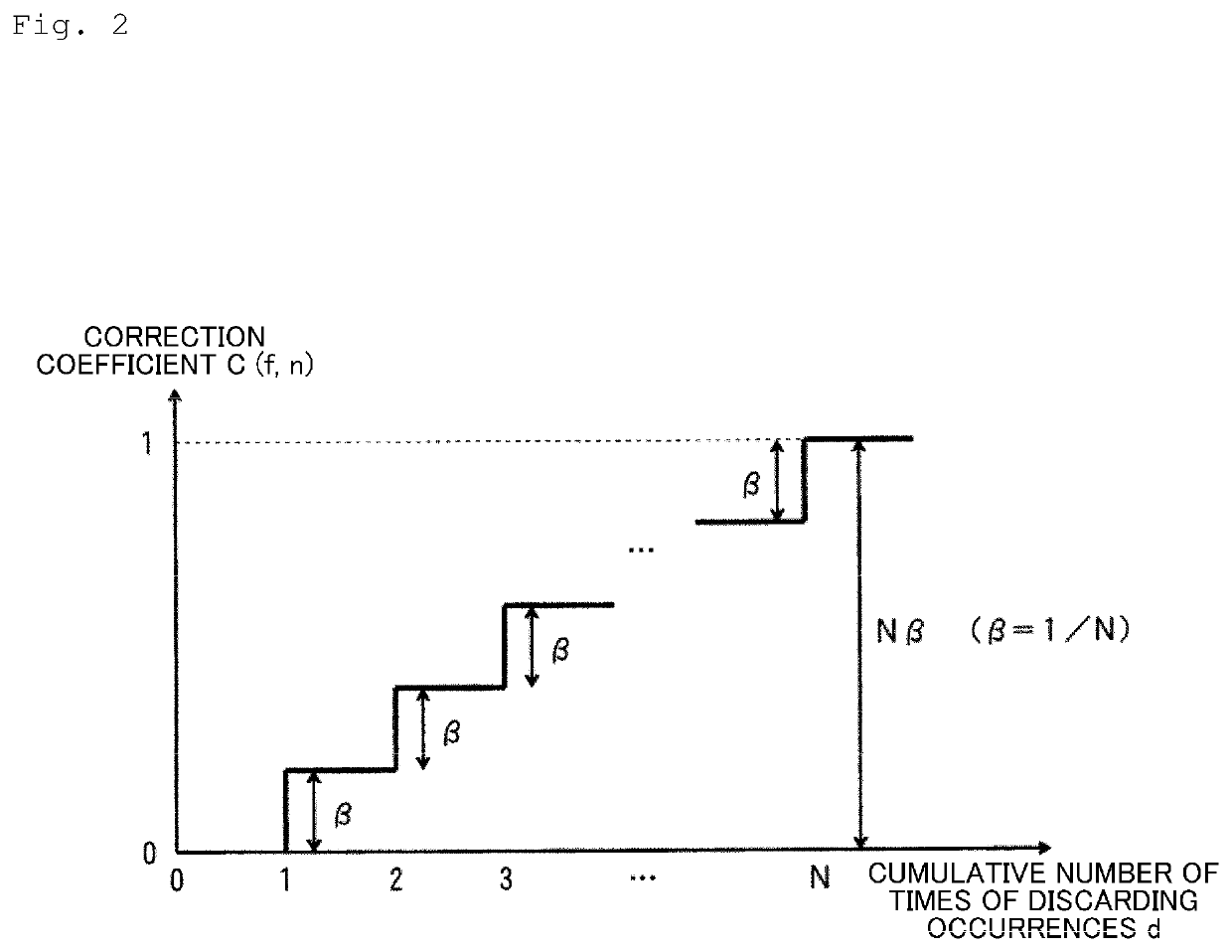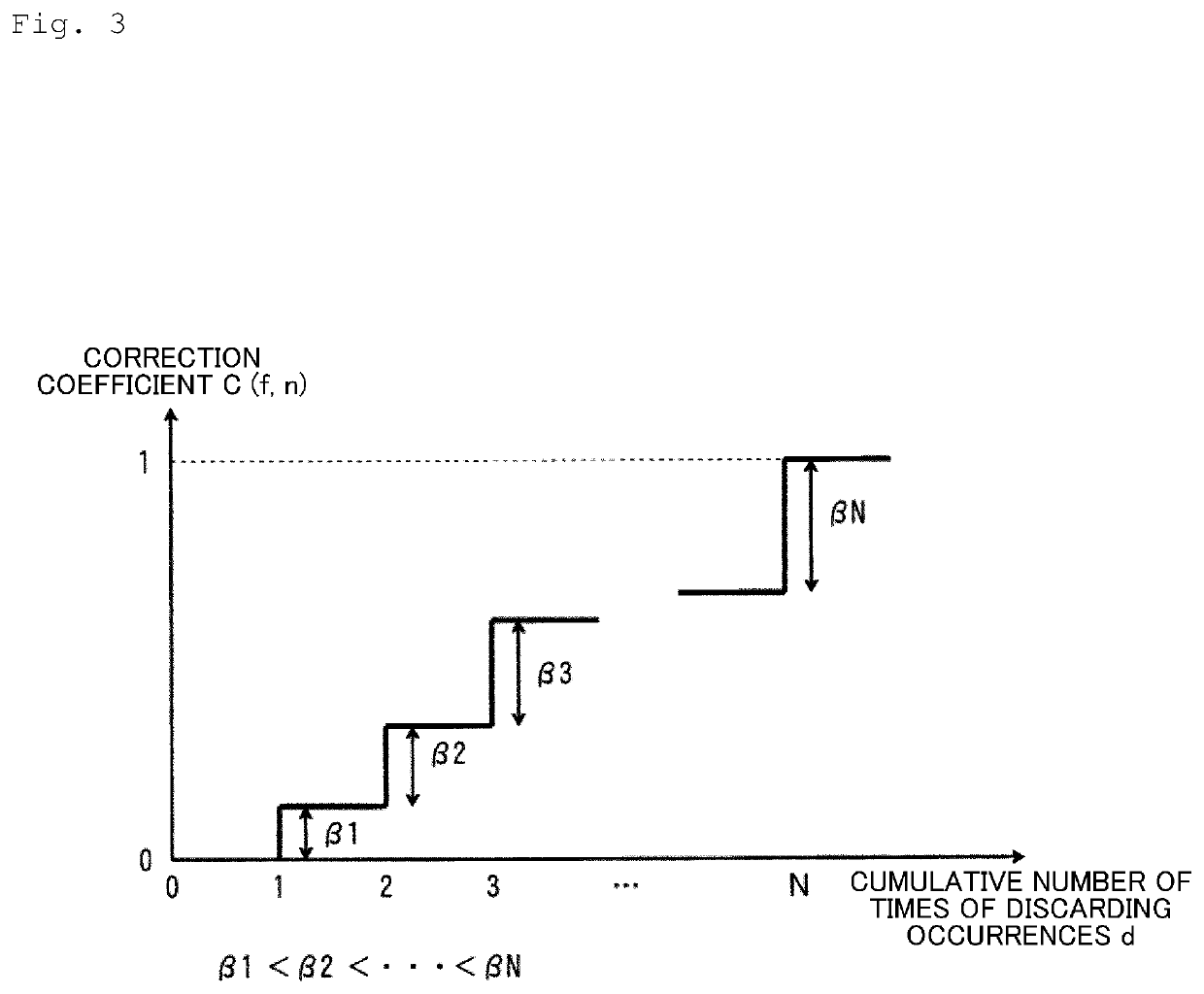Communication control system, communication control method, communication control apparatus and communication control program
- Summary
- Abstract
- Description
- Claims
- Application Information
AI Technical Summary
Benefits of technology
Problems solved by technology
Method used
Image
Examples
first embodiment
[0044]FIG. 2 illustrates an outline of updating the correction coefficient C(f, n) in a first embodiment.
[0045]In FIG. 2, the horizontal axis represents the cumulative number of times of discarding occurrences d, which is the cumulative number of times the amount of discarded data collected for the flow ID: f from SW #n was not 0. The vertical axis is the correction coefficient C(f, n) collected for the flow ID: f from SW #n, where the correction coefficient is β for a cumulative number of times of discarding occurrences d of 1 and increases by 3 each time the cumulative number of times of discarding occurrences d increases by 1, and its upper limit is 1. Accordingly, the correction coefficient C(f, n) is given by the following equation.
C(f,n)=min(1,d×β)
[0046]Here, β is a predetermined value, and for example, in a case where the cumulative number of times of discarding occurrences when the correction coefficient C(f, n) reaches the upper limit of 1 is set to N, it is represented as
β...
second embodiment
[0049]FIG. 3 illustrates an outline of updating the correction coefficient C(f, n) in a second embodiment.
[0050]In FIG. 3, the horizontal axis represents the cumulative number of times of discarding occurrences d. The vertical axis is the correction coefficient C(f, n) collected for the flow ID: f from SW #n, and the correction coefficient increases by βd according to the cumulative number of times of discarding occurrences d. Accordingly, the correction coefficient C(f, n) is set as
β1,β2, . . . ,β(N−1),βN
according to the cumulative number of times of discarding occurrences d. Here, N is the cumulative number of times of discarding occurrences when the correction coefficient C(f, n) reaches 1, and
β1,β2, . . . ,β(N−1)N
may be set so that the rate of increase in the correction coefficient C(f, n) increases as the cumulative number of times of discarding occurrences d increases. Or
β1,β2, . . . ,β(N−1)>βN
may be set so that the rate of increase in the correction coefficient C(f, n) dec...
third embodiment
[0051]FIG. 4 illustrates an outline of updating the correction coefficient C(f, n) in a third embodiment.
[0052]In FIG. 4, the horizontal axis represents the cumulative number of times of discarding occurrences d. The vertical axis is the correction coefficient C(f, n) collected for the flow ID: f from SW #n, where the correction coefficient is α for a cumulative number of times of discarding occurrences d of 1 and increases by β each time the cumulative number of times of discarding occurrences d increases by 1. Accordingly, the correction coefficient C(f, n) is given by the following equation.
d=1:C(f,n)=α
d≥2:C(f,n)=min(1,α+d×β)
[0053]Here, α and β are both predetermined values, and for example, are represented as
α=δ / γ
β=(1−α) / (N−1)
where γ [s] is a collection time interval of the amount of discarded data, δ [s] is an average length of microbursts, and N is the cumulative number of times of discarding occurrences when the correction coefficient C(f, n) reaches the upper limit of 1. In ...
PUM
 Login to View More
Login to View More Abstract
Description
Claims
Application Information
 Login to View More
Login to View More - R&D
- Intellectual Property
- Life Sciences
- Materials
- Tech Scout
- Unparalleled Data Quality
- Higher Quality Content
- 60% Fewer Hallucinations
Browse by: Latest US Patents, China's latest patents, Technical Efficacy Thesaurus, Application Domain, Technology Topic, Popular Technical Reports.
© 2025 PatSnap. All rights reserved.Legal|Privacy policy|Modern Slavery Act Transparency Statement|Sitemap|About US| Contact US: help@patsnap.com



